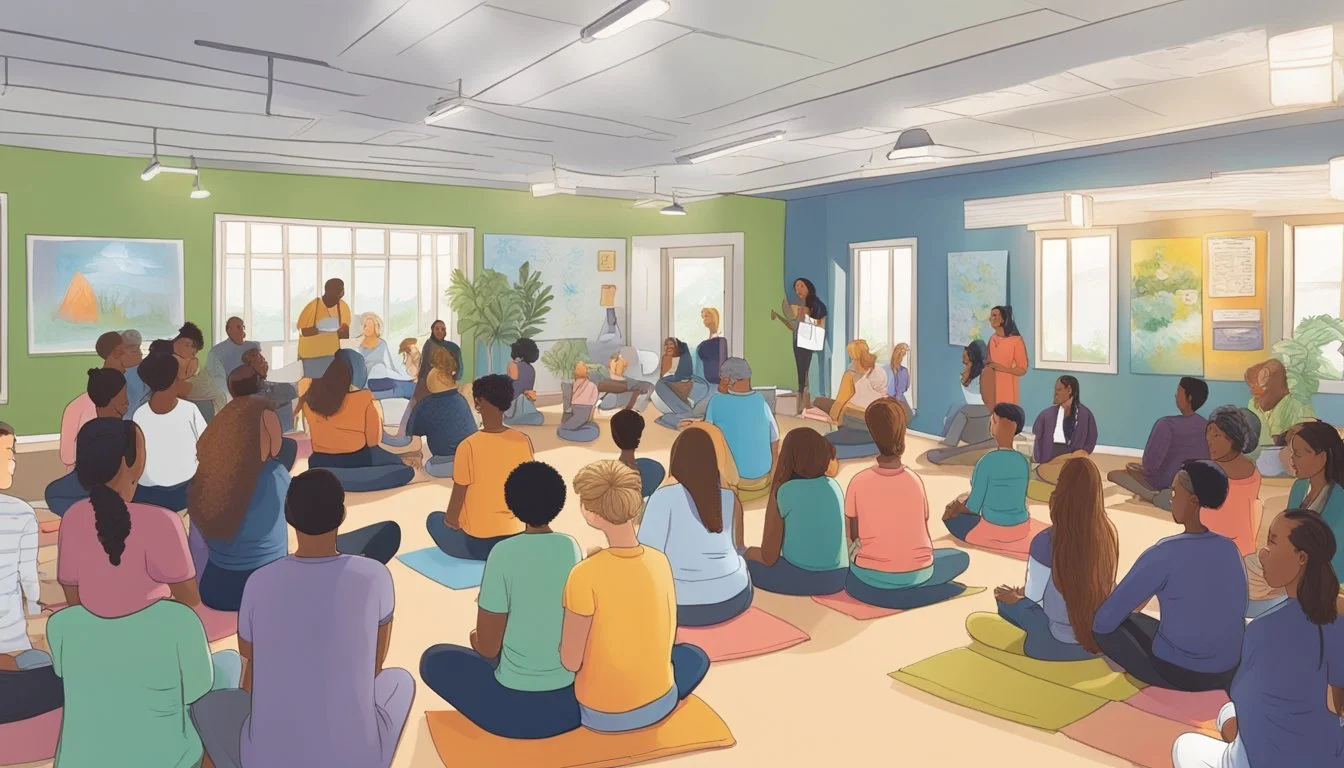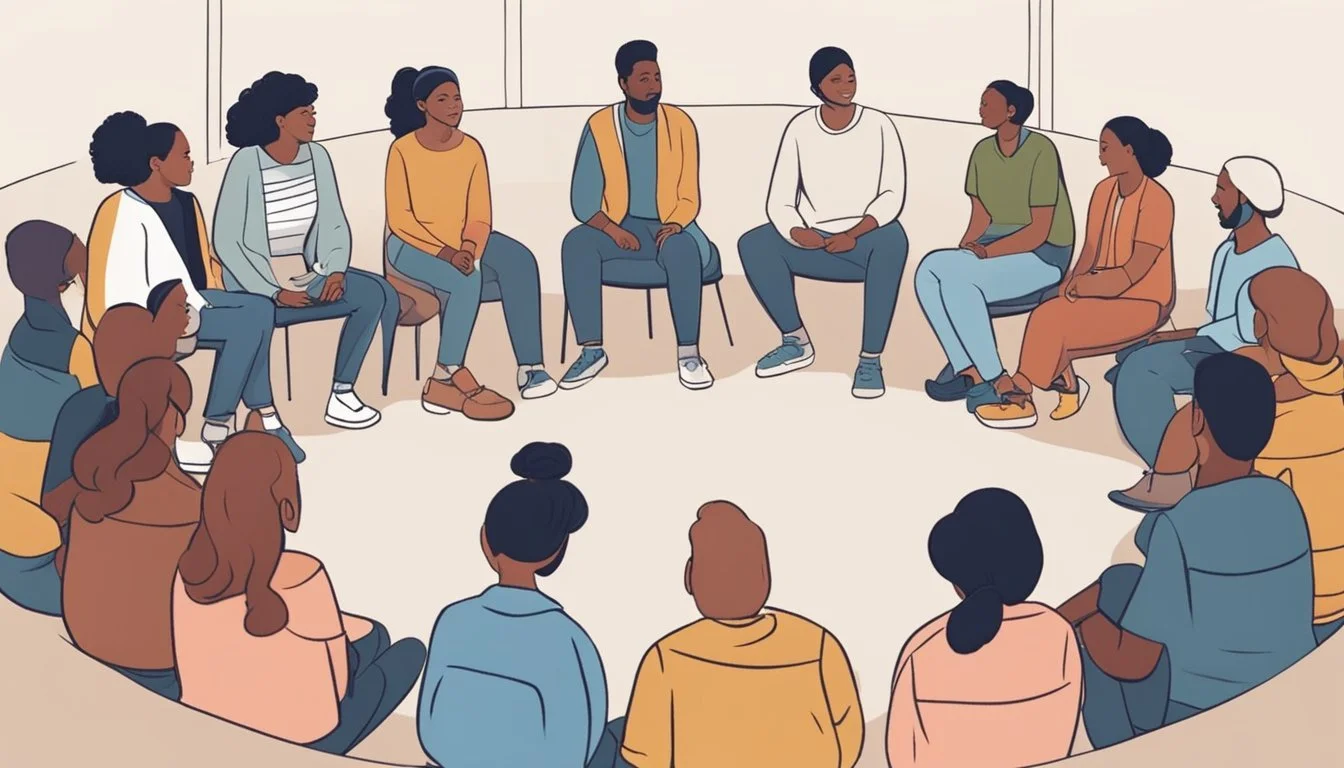12 Ways to Create a Supportive Environment for Trauma Survivors
Practical Tips and Strategies
Creating a supportive environment for trauma survivors is essential for fostering healing and recovery. Trauma can have lasting impacts on an individual's mental, emotional, and physical well-being, making it crucial to provide spaces that promote safety, trust, and comfort. Understanding how to design such environments can significantly enhance the healing process and aid in the overall well-being of trauma survivors.
The strategies employed range from physical setups to emotional support mechanisms. A well-thought-out environment not only helps in reducing anxiety and stress but also empowers trauma survivors by giving them a sense of control and safety. By implementing thoughtful measures, anyone can contribute to creating a nurturing space that encourages recovery.
1) Provide Safe Communal Spaces
Creating safe communal spaces is essential for trauma survivors. These spaces should be designed to promote both physical and emotional safety. Comfortable furniture and soothing color schemes can make a significant difference.
A clutter-free environment is crucial. Spaces should be organized to reduce stress and anxiety. Incorporating soft textures like plush rugs and throw pillows can add warmth and comfort.
Communal spaces should encourage open communication. Actively listening to survivors when they choose to share their experiences is important. Sharing personal stories of overcoming trauma can also help create a supportive atmosphere.
Inclusive communal spaces are vital. Ensure that these areas accommodate the diverse needs of trauma survivors. This includes considering physical accessibility and creating an emotionally supportive environment.
Safe communal spaces can also serve as informal gathering places. They can be especially beneficial for those who might hesitate to seek help on their own. This helps in fostering a sense of community and shared healing.
2) Offer Regular Counseling Sessions
Providing consistent and regular counseling sessions is crucial for trauma survivors. Regular sessions ensure that individuals have a reliable space to process their experiences and emotions. This practice builds a sense of stability and safety.
Weekly or bi-weekly sessions are often recommended. Frequent meetings help maintain momentum in the healing process and prevent feelings of isolation. Trust and rapport can develop more naturally over time with consistent interaction.
Counselors should focus on creating a safe and supportive environment during these sessions. It is essential to listen actively and demonstrate empathy. This helps survivors feel understood and validated.
Confidentiality in these sessions cannot be overstated. Ensuring privacy allows clients to open up without fear of judgment or exposure. Maintaining a controlled environment free from interruptions is key.
Regular sessions contribute to building a therapeutic relationship. This relationship is foundational for effective trauma therapy. Effective counseling can significantly aid in the rebuilding of an individual's sense of control and empowerment.
In addition to individual sessions, group counseling can also be beneficial. Group settings provide a sense of community and shared experiences. This can be particularly powerful for those who feel isolated by their trauma.
3) Create Peer Support Groups
Peer support groups offer an invaluable space for trauma survivors to connect with others who have similar experiences. These groups provide mutual support and help lessen feelings of isolation and loneliness. Sharing emotions and coping strategies can significantly enhance each member's ability to manage their trauma-related stress.
Facilitating peer support groups requires careful planning. It's important to establish a safe and welcoming environment where participants feel comfortable sharing their experiences. Confidentiality should be strictly maintained to build trust among group members.
Groups can be structured or open-ended. Structured groups follow a specific agenda or focus on certain topics, while open-ended groups allow for more free-flowing discussions. Both formats can be effective, depending on the needs of the participants.
Including trained facilitators or mental health professionals can help guide discussions and provide additional support. These individuals can ensure that conversations remain constructive and that any crisis situations are appropriately managed.
Support groups like those offered by the Trauma Survivors Network can be particularly beneficial. They connect trauma survivors, providing emotional relief and enhancing coping skills. Additionally, ensuring the availability of online groups can help reach those who may not be able to attend in-person sessions.
Ultimately, peer support groups serve as a powerful tool in the healing journey of trauma survivors. They foster community, empathy, and empowerment, aiding individuals in their path toward recovery.
4) Ensure Confidentiality
Ensuring confidentiality is vital to creating a supportive environment for trauma survivors. Individuals need assurance that their personal information and experiences will not be shared without their consent. This builds trust and encourages open communication.
Confidentiality can be maintained by establishing clear policies about privacy. These should be communicated to all staff and reinforced regularly. Confidential discussions should always take place in private settings.
Staff should be trained to handle sensitive information appropriately. This includes understanding the legal and ethical obligations related to confidentiality. They should avoid discussing private matters in public areas or with unauthorized individuals.
Utilizing secure systems for storing and transmitting information is also important. Digital records should be encrypted, and access should be limited to authorized personnel only. Physical records should be kept in locked cabinets.
For more detailed guidelines and strategies, you can explore information provided by Wellspring Center. This resource outlines practical steps to ensure that confidentiality is upheld in trauma-informed care environments.
By prioritizing confidentiality, organizations can foster a sense of safety and trust, which is crucial for the healing process of trauma survivors.
5) Educate about trauma responses
Educating staff and students about trauma responses is essential. Understanding these responses can reduce stigma and promote empathy.
Trauma can affect behavior, emotional regulation, and academic performance. Students may exhibit reactions such as aggression, withdrawal, or hyperactivity.
Providing training on trauma responses helps educators recognize these signs. When teachers know what to look for, they can respond appropriately.
Using resources that discuss key components of trauma-sensitive approaches, such as those found through the National Center on Safe Supportive Learning Environments, can be beneficial.
Moreover, implementing practical guidance, like rhythmic music for calm and sensory breaks, can support students. These practices can decrease the likelihood of triggering trauma responses.
Teachers should also engage with materials that discuss the establishment of environments less likely to activate trauma, as noted in the REL Appalachia PDF.
It's important to include parents and caregivers in this educational process. This collective effort ensures everyone understands trauma responses and works together to support affected students.
Ultimately, education about trauma responses empowers both teachers and students. It fosters a safer, more inclusive learning environment.
6) Implement Trauma-Informed Policies
Organizations should adopt clear policies that prioritize the safety and well-being of trauma survivors. These policies should integrate trauma-sensitive practices into every aspect of service delivery.
Policies must promote a culture of understanding and empathy. This includes staff training to recognize signs of trauma and respond appropriately.
Procedures need to be designed to minimize re-traumatization. This means creating a physically and emotionally safe environment for survivors.
Providing continuous support and resources is crucial. This can include mental health services and support groups to help survivors heal and recover.
A structured feedback mechanism should be in place. It allows survivors to voice their concerns and experiences, ensuring the policies remain effective.
Adopting a trauma-informed approach helps healthcare organizations address patients' needs more effectively.
Regularly revisiting and updating policies is essential. Trauma-informed care evolves, and policies must reflect the latest practices and understanding.
7) Encourage self-care routines
Encouraging self-care routines is vital for trauma survivors. It can significantly aid in their healing journey by promoting physical and emotional well-being. Simple actions like brushing teeth, washing the face, or taking a shower can have a profound impact. These small steps can help individuals regain a sense of control over their lives.
Physical activities such as mild exercise should be encouraged. Regular movement can help reduce stress and improve mood. Mindful breathing exercises or meditation can be particularly beneficial for managing symptoms of PTSD or complex trauma. These practices help regulate emotional responses and enhance relaxation.
Creating a calming environment is another effective strategy. Suggest using soothing elements like essential oils or bath bombs during baths. This can transform a routine activity into a therapeutic experience. Participation in support groups or group chats can also provide positive reinforcement and a sense of community.
Encourage survivors to engage in activities they enjoy. Whether it’s reading, drawing, or listening to music, these activities can offer both distraction and joy. Emphasizing the importance of self-care routines helps trauma survivors reclaim their sense of self and foster resilience.
For more ideas on self-care techniques, visit Beauty After Bruises.
8) Promote Physical Wellness Activities
Engaging in physical activities can be an effective method for trauma survivors to process emotions. Exercise releases endorphins, which can help improve mood and reduce anxiety. Activities like yoga, walking, or swimming create a mindful experience that centers around the individual's immediate needs.
Trauma-informed physical activities focus on safety and comfort. Gentle movements in a low-stress environment ensure participants feel secure. This can be beneficial for enhancing both physical and mental health.
Group activities can also foster a sense of community and support. Exercising with others can reduce feelings of isolation and build trust. It's important that these activities are inclusive and respect the varied abilities and preferences of individuals.
Physical wellness activities should incorporate trauma-informed practices by centering an individual's needs. This can make the experience more impactful and supportive for those healing from trauma. For more information on promoting healing through physical activities, visit How to promote healing with physical trauma-informed practices.
9) Use Positive Reinforcement
Positive reinforcement can significantly impact the healing journey of trauma survivors. Acknowledging and praising even small steps toward recovery helps build confidence and resilience.
Encouragement plays a crucial role in reinforcing their progress. Simple acts like expressing pride in their achievements or recognizing their effort can boost their morale.
Offer genuine compliments and avoid any hint of condescension. Celebrating successes, no matter how small, can motivate them to continue their healing process.
Positive reinforcement should be consistent. Regularly acknowledging their progress makes them feel valued and supported. This can come from friends, family members, or therapists.
Being specific in your praise is more effective than vague compliments. For example, saying, "You showed great strength in sharing your story today," highlights their specific achievements and reinforces their behavior.
Incorporate positive reinforcement into daily interactions. These moments can make a significant difference in their recovery journey, helping them see their worth and potential.
10) Provide access to mental health resources
Offering mental health resources is crucial for supporting trauma survivors. Access to therapists, counselors, and support groups can significantly aid in the healing process.
Creating a directory of local mental health professionals can be a practical first step. This allows individuals to find and reach out to qualified experts easily.
Online resources, such as teletherapy and mental health apps, can also make support more accessible. These tools offer flexibility for those who prefer or need remote options.
Facilities should have information on various services, such as crisis hotlines and specialized trauma support programs. This ensures individuals can find help when they need it most.
By incorporating these resources, a supportive and effective environment for trauma recovery can be established.
11) Facilitate open communication channels
Creating open communication channels is crucial for supporting trauma survivors. Clear, empathetic, and honest communication ensures that survivors feel heard and validated. This involves actively listening without judgment, which helps build trust.
Encouraging open conversations about mental well-being can empower trauma survivors. Facilitators should ask thoughtful, open-ended questions to show genuine interest. This enables survivors to share their experiences at their own pace.
Offering multiple avenues for communication, such as face-to-face meetings, telephone calls, or digital platforms, caters to diverse needs. Flexibility in communication methods can significantly enhance a survivor's comfort level and willingness to engage.
Using culturally sensitive language and respecting individual boundaries are also vital. Adapting the conversation style to the survivor’s cultural background and comfort zone supports a more inclusive environment.
Educational resources can be beneficial. Providing information about trauma effects and potential recovery pathways helps survivors understand their journey better, enabling more meaningful conversations.
Lastly, regular check-ins reinforce the support system. By maintaining consistent and dependable communication, facilitators can help survivors gradually rebuild their confidence and sense of safety.
12) Train staff in trauma sensitivity
Training staff in trauma sensitivity equips them with the skills to better support students who have experienced trauma. It builds awareness of how trauma affects behavior and learning.
A good starting point would be professional development sessions. These can introduce staff to the impact of trauma and trauma-sensitive practices.
Materials such as online modules and handouts can supplement training. For example, the Trauma-Sensitive Schools Training Package offers comprehensive resources for schoolwide implementation.
Regular training ensures that trauma-sensitive practices are consistently reinforced. School leaders can use handouts during staff meetings to revisit essential concepts.
Engaging the entire school staff is crucial. Everyone from teachers to administrative staff should understand and adopt trauma-sensitive approaches.
Continuous learning helps maintain a supportive environment. Revisiting key principles periodically ensures that the strategies remain effective.
Resources like the National Center on Safe Supportive Learning Environments offer ongoing support for incorporating trauma sensitivity into school policies and practices.
Understanding Trauma
Trauma often results from overwhelming, harmful experiences. Understanding its types and symptoms helps in providing better support to those affected.
Different Types of Trauma
Acute Trauma: This type stems from a single distressing event, such as an accident or natural disaster. The intensity of the event makes a major impact, leading to significant distress.
Chronic Trauma: Resulting from repeated exposure to stressful situations, chronic trauma can include ongoing abuse, domestic violence, or long-term illness. The persistence of stressors usually deepens the emotional impact.
Complex Trauma: This involves exposure to multiple traumatic events, often of an invasive, interpersonal nature. Complex trauma is common in situations like child abuse or extensive domestic violence where the survivor faces prolonged periods of harm and emotional turmoil.
Common Reactions and Symptoms
Emotional Reactions: Individuals may face intense fear, anxiety, and depression. These reactions can disrupt everyday activities and relationships.
Physical Symptoms: People might experience insomnia, fatigue, and hypervigilance. These physical signs often coincide with emotional stressors, making the trauma more challenging to manage.
Behavioral Changes: Survivors may become withdrawn or exhibit aggression. Changes in behavior can serve as coping mechanisms but may also indicate deeper struggles with trauma.
Cognitive Effects: Trauma can impair concentration and memory. These cognitive symptoms impact an individual's ability to function effectively in various settings.
Understanding these different aspects of trauma is crucial for creating a supportive and empathetic environment for survivors.
Creating a Safe Physical Space
Creating a supportive environment involves prioritizing privacy and comfort alongside inclusive design principles. These elements enhance safety and emotional well-being for trauma survivors.
Privacy and Comfort
Privacy and comfort are paramount in designing spaces for trauma survivors. To achieve this, consider using soundproofing materials to minimize intrusive noises. Soft lighting helps create a calming atmosphere, reducing anxiety triggered by harsh lights.
Comfortable furniture with soft textures like plush rugs and throw pillows provides a sense of warmth and security. Maintain a clutter-free environment by organizing spaces efficiently and avoiding overwhelming designs.
Incorporate private areas where individuals can retreat and feel secure. Ensure these areas are easily accessible but secluded enough to eliminate feelings of exposure or vulnerability. Thoughtful placement of furniture to create natural barriers can foster a sense of privateness without overt isolation.
Inclusive Design Principles
Design principles should be inclusive, ensuring that every individual feels safe and valued. First, ensure adequate lighting throughout common areas without creating harsh or glaring spots. Clear pathways with accessible entrances and exits facilitate easy movement and help prevent feelings of entrapment.
Sufficient space for comfort and privacy needs to be provided, allowing room for personal space without feeling cramped. Deploy ergonomic and adaptable furniture to cater to diverse physical needs.
Staff should be trained to monitor the environment to prevent behaviors that may come off as intrusive or harassing. Inclusive design extends to incorporating feedback from trauma survivors to continuously improve the space.
Creating such environments ensures a supportive atmosphere that can significantly aid in the healing process.
Building Emotional Support
Creating emotional support is essential for trauma survivors. This involves using active listening techniques and validating their feelings and experiences to foster trust and comfort.
Active Listening Techniques
Active listening is crucial in building emotional support. When engaging with trauma survivors, it's important to give undivided attention. Maintain eye contact to show genuine interest and avoid distractions such as phones or other people.
Use reflective listening techniques, such as paraphrasing what the survivor has said to ensure understanding and clarity. Phrases like, "What I hear you saying is..." can be very reassuring. Avoid interrupting or offering unsolicited advice, as these actions can make the person feel invalidated or dismissed.
Non-verbal cues, such as nodding and leaning slightly forward, signal engagement and empathy. Ask open-ended questions to encourage deeper sharing, like “How did that make you feel?” or “Can you tell me more about...?”
Validating Feelings and Experiences
Validation helps survivors feel acknowledged and understood. Acknowledge their feelings without judgment or criticism, using phrases like “It’s understandable that you feel this way” or “Your feelings are completely valid after what you’ve been through.”
Avoid minimizing their experiences or suggesting they should "move on." Trauma can have long-lasting effects, and it's important to respect their journey. Express empathy by saying, “I’m really sorry that happened to you,” which can significantly ease their emotional burden.
Encouraging them to share more about their experiences while validating their emotions promotes a sense of safety and belonging. These actions are fundamental in rebuilding trust and facilitating healing for trauma survivors.









